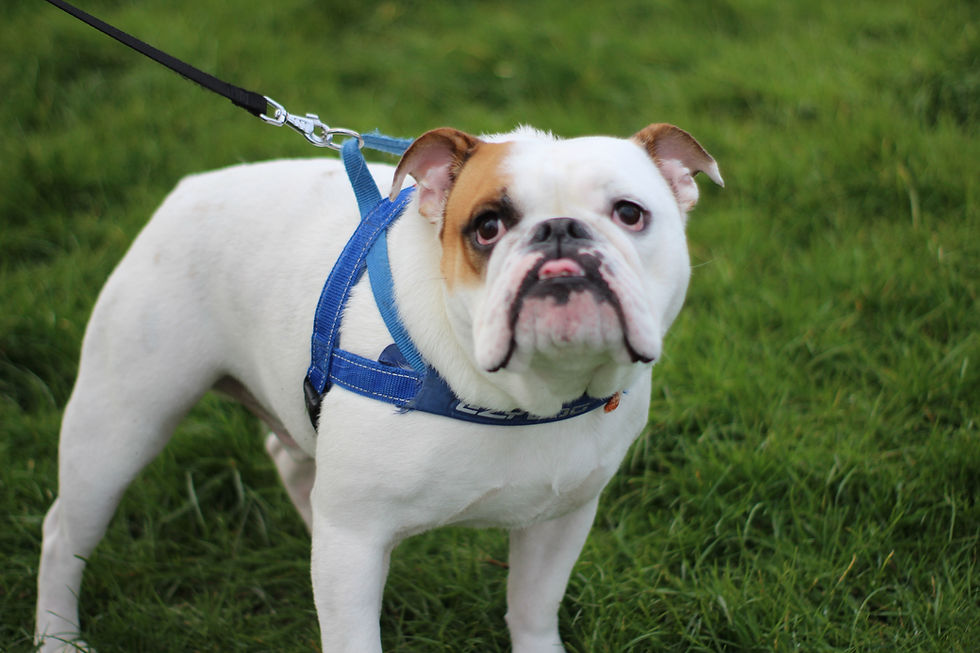
Separation Anxiety in Dogs
- Heidi
- Apr 29
- 4 min read
Why Penny the Goldendoodle Could Win an Oscar
If you’ve ever left your house for 30 minutes only to return to a scene of shredded throw pillows, chewed doorframes, and a dog acting like you were gone for 30 years, welcome to the world of canine separation anxiety.
Take Penny, for example - Tony’s lovable Goldendoodle and part-time escape artist. If Tony so much as turned on the shower, Penny would spiral into full panic mode. Once, she hurled herself through the backyard fence like a woolly missile. Another time, she howled so long and so dramatically that her bark went raspy…..she sounded like a chain-smoking jazz singer for two days.
But don’t worry: Penny’s not alone, and neither are you. Separation anxiety is incredibly common, especially in social, intelligent breeds like doodles, retrievers, shepherds and honestly, anything with four legs and a heart.
Let’s dig into why it happens, how to help and whether leaving Alexa to play “dog music” while you’re out is genius (spoiler: it is).
Why Dogs Get Separation Anxiety
Dogs are pack animals and you, lucky human, are their pack. When you leave, especially suddenly or for long periods, it can cause stress, panic, and in extreme cases, destruction.
Some causes include:
Lack of early independence training
Sudden changes in routine (like returning to work after months at home)
Moving to a new home
Being rehomed or rescued
Basically, if your dog was a person, they’d be texting you “where r u” 400 times an hour.

How LongCan You Leave a Dog Alone?
Here’s the not-so-fun truth: dogs don’t do well alone for long. While adult dogs can physically go 6–8 hours without a potty break, emotionally, many start to unravel much sooner, especially without stimulation.
Think of it like leaving a 5-year-old human alone with no TV, books or snacks. After an hour, the child is bored. After three, they’ve painted the cat, built a pillow fort, and probably found your chocolate stash. Dogs are no different.
Puppies should never be left alone for more than 2–3 hours, while adult dogs max out around 4–6 hours unless they’re exceptionally chill (or secretly part cat).
Tips to Reduce Separation Anxiety (Besides Quitting Your Job)
1. Use Background Noise. Personally, I use dog music on Alexa
Music designed for dogs really does help. The science behind it shows that classical music, ambient sounds, and even heartbeat rhythms can reduce anxiety. Tony and I cue up Alexa to play calming dog playlists when we leave, and Penny now associates the dulcet tones of “Mozart for Mutts” with nap time, not doom.
Try:
“Dog Music” or “Calm Pet” playlists
White noise machines
Audiobooks with calm narrators (Sir David Attenborough )
2. Create a Safe Space
Some dogs do better with the run of the house, while others prefer a smaller, secure area like a cozy room or crate. It depends on your dog’s personality.
Free roam: Great for confident, non-destructive dogs.
Small space: Ideal for anxious dogs who find comfort in a den-like setting.
Just don’t make the space too isolated, no one wants to feel like they’re being punished.
3. Desensitize Their Departure Triggers
Dogs are smart. They know the sound of your keys, the sight of your shoes, or the jingle of your car fob. Start mimicking these actions without leaving to break the association. Put on your coat, then make a sandwich. Grab your keys, then watch Netflix.
Soon, they’ll stop panicking every time you zip up your jacket.
4. Practice Short Departures
Start with 1–2 minute absences. Come back before your dog starts to freak out. Gradually extend the time. Penny used to panic if Tony left for a shower. Now she barely looks up if he steps out for a coffee (unless he forgets the Puppuccino).
5. Leave Enrichment Toys
Frozen Kongs, treat puzzles, snuffle mats, these are your best friends. Not only do they distract your dog, but they also create positive associations with your leaving.
Bonus:A tired brain = a calm dog.
Should You Consider a Dog Walker or Daycare?
If your schedule means long stretches away, consider a trusted dog walker (like us …the pros at Barks and Parks, who even send adorable walk videos!) or occasional doggy daycare. Even once or twice a week can break up the monotony and reduce anxiety.
Final Thought: You’re Not a Bad Pet Parent
Separation anxiety isn’t your fault and with the right tools, your pup can learn to feel safe and secure when you’re gone. Just remember: if Tony and Penny can go from fence-leaping panic to peaceful solo afternoons with a side of Mozart, so can your dog.
And if all else fails…you could always leave a life-sized cardboard cutout of yourself in the living room. We’re not saying it works, but we’re also not not saying it works.😂
Need help breaking up your dog’s day? Reach out to Barks and Parks - Mississauga’s most trusted dog walkers and boarders. Because your pup deserves more than just waiting by the door.





I never thought my girl would ever listen and return. Tried and stuck to the tips and she is staying with me and returning. Much more fun for both of us.
Going to start trading this weekend. Great and easy to follow tips
Very helpful ! Thanks you